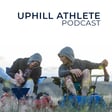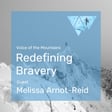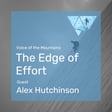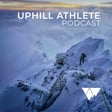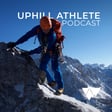Introduction to Hosts and Series
00:00:02
Speaker
mission is to educate and celebrate all mountain athletes. My name is Steve House and I will be your host today along with Alyssa Clark and Chantal Robitaire.
Overview of Aerobic Threshold Testing
00:00:13
Speaker
Today we will be continuing our series on training for mountaineering. In the last episode we covered the fundamentals of aerobic base training and we will now dive into the aerobic threshold test, discuss some of the
00:00:28
Speaker
your test results, and cover the how and why of setting zones.
Significance of Aerobic Threshold Test
00:00:43
Speaker
Welcome Chantel and Alisa. Chantel, would you like to start us off by talking about what an aerobic threshold test is?
00:00:53
Speaker
Yeah, absolutely. So in the last episode, we talked a lot about how when we are doing longer events, we are really relying on our aerobic metabolic pathways. So the more energy our aerobic metabolism can produce, and the faster that it can do it, the longer we can sustain higher outputs. So that's endurance. And an aerobic threshold test helps us determine our aerobic fitness, and it also helps us
00:01:20
Speaker
determine appropriate training intensities so that we can have the opportunity to improve the health of our aerobic engine. Because if we don't know where we're starting, it's hard for us to know how much we're improving. So we've got to have that start point to help guide us along the path. That's great. Alisa, do you have any observations to add about that?
00:01:45
Speaker
No, you know, after being a part of the email, I think it's one of the questions that we get the most because it is what we start out with for most all of our
00:01:57
Speaker
our training plans and all of our training, we start with the aerobic threshold test and I know that it can cause quite a bit of confusion of like, how do we run it? What are we aiming for? Why is
Methods for Conducting Aerobic Threshold Tests
00:02:09
Speaker
this important? Because most people get into the anaerobic threshold test or they think that's what they need to do. So I think that this is such a great way to clarify
00:02:18
Speaker
some of the confusion and just really get into the reasonings of why we do this test and its importance in especially the type of training that we have our athletes do, why we do it. So with that being said, there are a couple of different methods that you can use to conduct an aerobic threshold test.
00:02:41
Speaker
like the math method, nose breathing, the heart rate drift test, blood lactate, gas exchange, et cetera. And I'd love to hear if you two, maybe Chantal can take the first three and Steve, you could take the second two, of kind of the pluses and minuses of each. And we also have a great article on a pillow athlete kind of explaining these as well, but I would love to hear you two talk about this.
00:03:11
Speaker
Sure. All right. I'll start off with the math test. And that is probably a lot of people remember this, maybe from even school days where you would take a formula with 100 minus your age, if you're training consistently, and then that would be, you know, your magic aerobic heart rate.
00:03:31
Speaker
Number so, you know on the positive side, it's very easy to calculate and it's very easy to understand what it is But it also the way that that formula is written It kind of suggests that as you get older you get more efficient at fat burning but there really isn't any evidence that shows us that a 30 year old would burn fat at a heart rate of 150 and a 50 year old would burn fat at
00:03:59
Speaker
at a heart rate of 130. So there's a lot of variability with this since it's a formula and we're all complex human systems. So it's a little bit hard to predict. And also if we think about the fact that heart rate is affected by a lot of different factors, right? It's affected by our caffeine consumption, maybe the last meal we ate, how well you slept,
00:04:23
Speaker
the temperature that's happening when you're out doing your exercise, altitude for women, menstrual cycle, lots of things. So having just one number rather than testing in a way where you get a range is a little bit maybe oversimplified. And so maybe there are better methods that we could use to be more accurate.
00:04:48
Speaker
If I may interject, we have a great podcast from an earlier episode where Phil Maffetone, who developed the Maffetone Aerobic Formula, I'm sorry, it's Maffetone Aerobic Function Formula, I believe. So Scott Johnson interviewed
00:05:10
Speaker
Phil Maffetone on the podcast. And Scott and Phil actually met back in the 70s in Boulder, Colorado. So they had a little bit of history, and Phil has a great podcast. And we'll link to that in the show notes because I think it will be really interesting for those of you that are interested to know more about it. There's also some modifiers that we suggest. Those are just on
00:05:38
Speaker
threshold self-assessment.
00:05:52
Speaker
Yeah, that's awesome. And it's always great to understand how these formulas are derived and the science behind them, the ideas behind them, and how they can be used. But it's nice, easy, quick calculation. And with some modifiers can be helpful for people to use that. The next one on your list, Alyssa, was nose breathing. And this is nice and simple. And the concept of this is if you're out
00:06:21
Speaker
If you're out running or doing your activity and you can breathe through only your nose, there's a strong chance that you're in an aerobic state. But there are some caveats to this, of course. What if you have asthma? What if you're recovering from
00:06:36
Speaker
a flu or a cold or things like that, that might not really work for you. What if it's really cold or hot outside? And also, I don't know if any of you have seen those videos of some collegiate athletes that were training like this and you see these athletes speeding around on a collegiate track with tape over their mouths. They are definitely not going, they are definitely not running within their aerobic zones.
00:07:03
Speaker
It's not, I don't think, a good test, but I do think it is a useful check-in for yourself. If you are out on a run and you're supposed to be within your aerobic range training zone, you are running around. You can test yourself to see if you're just breathing through your nose, and so that's a nice, easy kind of check-in, but I wouldn't say that it would be an accurate method to determine necessarily your aerobic training bandwidth.
00:07:31
Speaker
Yeah, I would add on to that. That's one of the cues I often use, especially with people who are starting to learn what that means is that I say like, okay, can you have a full conversation? Is it starting to get harder to talk? Can you breathe out of your nose? And so I think it's a great way because I think especially
00:07:54
Speaker
for newer athletes and myself included in that, it can get tiring and sometimes sad to just constantly be looking at your watch being like, oh my gosh, am I still in my zones? And it is important to check, but I do think that that's a great way to just kind of recenter yourself. Like, okay, am I breathing way too hard? Can I hold on to a conversation? And so that's one of the ones I really like. It kind of goes into perceived effort.
00:08:22
Speaker
as well. But I like to use that one as a cue. Those of you that have been following up an athlete for a long time will recall that when we published the training for the new albinism book, we relied almost exclusively on this test. And the reason we actually kind of started to move away from it is when we found with athletes that were really new
00:09:08
Speaker
fitness space. Definitely. And I think that, um, Zoe Nance, one of our coaches is working really hard on a great, um, rate of perceived effort, uh, kind of chart that I think will be really useful for people to see and take, um, as well, kind of going along with this concept that Steve was mentioning. I think that'll be really useful for our athletes because it's important to not only know
00:09:38
Speaker
the goal of your workout, what zone you're supposed to be in and knowing what those are and being able to trust that information for yourself, but also to be able to check in with yourself when you're out doing your activities and making sure that you are in the correct zone. As Alyssa said, it can be kind of tiresome sometimes to continually look down at your watch.
00:09:59
Speaker
So being able to make kind of a mind body connection with how you're breathing and how you're feeling is, is really good. And I think it, it helps build our confidence too, right? When we're out there feeling good about, uh, the fact that we're doing the right things for our training. Definitely. Yeah. I feel like it it's always, I like to think of it as an honesty check. Um, yeah, definitely. Yeah. So the next one I have is, um, heart rate drift test. So I'm telling if you want to take that one on and then
00:10:29
Speaker
Yeah, absolutely. So the heart rate drift test is a really nice, simple and reliable test. It's a great way to determine your aerobic threshold, but it's also again another great tool that you can use as an inactivity check-in. And due to the fact that it is a simple and reliable test, that has kind of become the go-to at uphill athlete for
00:10:56
Speaker
determining the workout zones. And so there are definitely on the website a lot of great articles you can read with some really good instructions on how to do this.
00:11:06
Speaker
But this basic, basically this simple test uses the idea that when you're able to hold your aerobic pace, your heart rate will remain fairly constant for as long as an hour. And maybe for some, you know, really experienced athletes longer than that. If your heart rate rises more than 5% at that steady pace, then it's more likely that you're starting heart rate
00:11:29
Speaker
was higher than your aerobic threshold and if your heart rate drift is less then maybe your starting heart rate was a little bit too low. So it's really easy for you to administer this test to get started and also with
In-Depth on Gas Exchange Tests
00:11:46
Speaker
looking at your data and training peaks after the fact, there's even a pace to heart rate ratio where you can look that up to see that you're in the right zone. And it's basically seeing how is your heart rate responding according to the pace that you're moving at. And it should be able to stay pretty stable for an hour. After that point, when you're starting to get tired,
00:12:08
Speaker
that's where we get the the cardiac drift where your effort level might or even your pace might even be decreasing a little bit but your heart rate is drifting upwards and so that is a really useful test. So Steve the next one we have is blood lactate if you want to talk about that a little bit. Yeah the blood lactate concentration test relies on a little device
00:12:41
Speaker
after doing a warm-up you do exercise at an aerobic pace and as you progress you gradually increase your pace usually in three-minute increments and every three minutes you actually take a little blood sample and you use those there's these old test strips to go with this little monitoring device and it
00:13:06
Speaker
gives you a measure of the actual lactate concentration in your blood. And I have one of these at home. I've used it quite a bit. It is accurate. It does help set this boundary of where your aerobic
00:13:26
Speaker
threshold is, which is also sometimes known as the maximum lactate steady state of 2.0 millimoles of lactate. And that does work, but the whole piece around having to prick your finger or prick an earlobe, get a drop of blood,
00:13:51
Speaker
The other problem is that sweat can contaminate the sample and then you don't get a good reading. It can be actually quite finicky to do and it takes a team of people. You can have the person doing the test and then you need a coach or somebody else actually taking the readings. It's easiest to do it on a treadmill, but people often don't like to do things on a treadmill, so that makes that hard. There's a lot of downsides and while it is accurate, it is techie and finicky.
00:14:27
Speaker
Yeah, kind of a personal anecdote. I went to a ski academy in high school and we used to do blood lactate testing for all of us. And I just remember being on a treadmill, putting your hand down, getting pricked, and it did take an entire team. And it was quite a process to get it done. But it's just so funny as a high schooler, you just kind of are like, cool, okay, go for it. But then now looking at it, it's just,
00:14:56
Speaker
that's such a very specific niche to be in a high school that was doing blood lactate testing at the age of like 14 years old. But it's just so funny to return to this and be seeing this test coming up. It's very accurate, but it is finicky and a lot of people don't really like getting their finger poked while they're running on a treadmill. Yeah, that was also my first exposure was as a junior Nordic ski racer at a summer training camp in
00:15:26
Speaker
long time ago, and we also ran some training seminars in various locations as a pill athlete, and we used to do this as part of the seminar, and it would take all day to get everybody in the seminar through blood lactate testing. There's just no fast way, an easy way to do it, so lots of downsides. But let's move on. Let's move on to some of the other things we can do.
00:15:52
Speaker
Yeah. So the last one, which I actually see people do more often as an alternative, uh, is gas exchange. So if we can go through just the pluses and minuses of that, and then we'll move on to what we recommend as a full athlete. Yeah, I can talk about that, but gas exchange test is done in a laboratory. You do use a treadmill.
00:16:19
Speaker
Typically, well, not typically, always you want to use the modality that you're most accustomed to. So if you're a cyclist, you do it on a bike. If you're a runner, you do it on a treadmill. They also make big treadmills I've seen for testing ski mountaineering athletes and for Nordic ski athletes and all these kinds of different things.
00:16:43
Speaker
big equine treadmills. Is that how you say that for horses? Those are wild to see horses getting VO2 max tests. Right. I've never actually seen one in person. I've always seen the equipment there. I've never actually seen it done. For the listeners, you have to Google a horse VO2 max test because it's unbelievable to watch. I can't imagine what the VO2 max of a horse must be. It must be like 200 or something. It must be just 200 or so strong.
00:17:13
Speaker
So yeah, lots of different ways to do that. We do want to caution people that you do need to really prep the lab as to what you're looking for and that you're not looking for a max VO2 test per se, although that can be part of the result you get. And we do have information on the website about it, including a PDF that you can download and share with the lab that basically lays out what you want
00:17:46
Speaker
increases the intensity too quickly without enough steps from one intensity to the next as they ramp up the speed of the treadmill are too short in duration and they miss the actual aerobic threshold boundary and go right into anaerobic because a lot of them are used to sort of people coming in from traditional anaerobic threshold
00:18:16
Speaker
first mentality and they're just trying to get an annual threshold number or a VO2 max number. But this is a great test because it's probably the most accurate. You're going to get a lot of information out of the test besides just your zones. The biggest downside is finding the lab and the cost. It's going to run you between probably $200 and $400. So it is a commitment in getting that done.
00:18:43
Speaker
I think it's important to point out those caveats to the listeners because they may be reading things about people getting VO2 max tests or they may be learning about someone doing VO2 max tests in their area. So it's important to understand how the data is derived, what we're testing, and with the gas exchange where we're looking at
00:19:08
Speaker
as the person is on the treadmill or looking at how much oxygen they're using, at what rate they're using oxygen at different levels of intensity, and also the exchange between the oxygen coming in and carbon dioxide going out. So you definitely can learn a lot of cool things, right? Like you said, Steve, you can learn your lactate thresholds. Sometimes they can combine that with this test. You can learn your
00:19:34
Speaker
heart rate and pace for different stages of the test. You can learn what your VO2 max is. You can also potentially learn if you give the right instructions to the tester, you can potentially learn what your aerobic threshold is, what your ventilatory thresholds are, you know, ventilatory threshold one and two, which can help give you some guidance and information for your both your aerobic threshold
00:19:59
Speaker
and your anaerobic threshold or lactate threshold. So that could be kind of useful. But again, it's really important to understand how the lab is doing the test, what type of protocol they're doing, and for you as an athlete, what you're hoping to gain from the test to be able to share that in a way so that the tester can give you the information that you feel you need to carry forward, however you're planning to use that data.
00:20:28
Speaker
Just as a funny anecdote, I'm friends with Reinhold Moesner and Peter Holler, and one time I heard them telling me about what happened before and after they climbed Everest without supplemental oxygen for the first time. It was, I believe, somebody's going to get mad at me, but I think it was 1978 or 79, but they did the
00:20:56
Speaker
before they left, I think in Zurich, and then immediately afterwards they flew them back. And, you know, the surprising thing is, the unsurprising thing is their VO2 max went up because they lost so much weight on the expedition. The surprising thing is that they didn't test that high. Like Peter's was pretty decent, but I think Reinhold's was like 42 or something. It wasn't like, you know, they were expecting these guys to be some sort of mutants and it wasn't like that. So I want to,
00:21:26
Speaker
say that because it's important not to get hung up with these numbers and try to connect your value as an athlete to numbers like this that actually don't really mean that much except whether or not we can move them and whether we can improve them and get better. And a lot of the results in sport actually have a lot more to do with
00:21:53
Speaker
efficiency and whether or not you get the good weather window and all these other periods of things. So just a little anecdote. Yeah, and I think that's a that's a really great thing to point out, right? Because people might look at someone like Killian Jornet, right? He is a, he is a very talented athlete in many ways, from a physiological perspective, but also from a technical perspective. And he has a very high VO two max, right? But for
00:22:21
Speaker
A lot of people, a lot of athletes may be really talented athletes and don't have such a high VO2 max. And VO2 max is to some extent, it's genetics, right? 80% of VO2 max is determined by genetics, 20% is trainable. So you can have some influence through your training on your VO2 max, but you have a lot more influence on improving your aerobic capacity and also improving your
00:22:49
Speaker
Lactate threshold and those are things that are not determined by our genetics They are those are things that we needles that we can move right by our training And I think that's why it's important to have if we have let's say our aerobic threshold as our benchmark We can use that to set our training zones. We can make sure that we're training the correct
00:23:09
Speaker
amounts at the correct intensities and that that allows us to make up the difference, right? If we are not genetically gifted athletes, we can still be incredible athletes and we can still make improvements no matter our training histories or even our ages. I love that. I think that's really important information for people because it can, sorry, my cat's trying to get in the podcast. It can
00:23:35
Speaker
I think deter people where they just think I'm not capable of accomplishing this and you can out train a lot or you can train through a lot. And I think particularly in endurance events, the mental component comes into such a strong play that I think it can overcome a lot of.
00:23:58
Speaker
genetics, I guess, is a way of putting it, uh, talent. I think talent matters in some cases, but not nearly as much in other cases. Um, so Chantel kind of touched on this already, but what does uphill athlete recommend as the method of conducting an aerobic threshold
Heart Rate Drift Test and TrainingPeaks
00:24:18
Speaker
test? And why do we recommend that? Steve, if you want to lead us off on that.
00:24:25
Speaker
Yeah, we mostly rely on the heart rate drift test and the reason is a lot of the points that Chantel touched on, it's reliable, it's simple, it's not very costly, it's repeatable, there's a lot of advantages to it.
00:24:56
Speaker
threshold test and usually it's a heart rate drift test. The only time it's not a heart rate drift test is if they're coming in with actual lab results. And those lab results look good, like, you know, hold together. And yeah, it's just a great way to do it. The only kind of downside is that you do need a tool like TrainingPeaks to analyze to quickly and easily measure that.
00:25:26
Speaker
And I would say the only other thing they need in addition to that is obviously their smartwatch that's capturing that information and a chest strap heart rate monitor so that we get the most accurate information compared to the unreliable nature of having the sensor on the wrist so that we want to make sure that we're getting good quality data that we're making those training suggestions on.
00:25:50
Speaker
Yeah, that is a great point and something we get pushed back on a lot because people don't like to have another thing and everybody thinks they already have a heart rate monitor on their wrist, but you really have to have the chest strap. And even if you don't have a watch, you can buy a chest strap for 50 bucks from Wahoo and link it to the Wahoo app and you can have a better heart rate monitor than
00:26:24
Speaker
Definitely. So with the actual test, um, we recommend two different ways of conducting this test. Um, but Chantal, I'd love if you were be able to explain a little bit of how to do each test. So one we have on the treadmill and then it's basically like inside and outside. Um, so I'd love to see. Inside and outside.
00:26:50
Speaker
Yeah, and that's going to obviously, you know, it's going to depend on, you know, if someone is not used to running on a treadmill, I would say don't even think about doing it on the treadmill because it can be stressful for some people to run on a treadmill if they're not used to it. And so that's obviously going to affect your heart rate.
00:27:09
Speaker
And maybe they're not comfortable. I remember in grad school working in a lab where we did a lot of testing on athletes. And so, Steve, you were talking about these big treadmills where you could actually use inline. We had like inline skaters on that and we had
00:27:28
Speaker
for some runners doing treadmill tests, we actually had to put them on that really big treadmill because trail runners take up space. They don't run in a really linear form and so their arms are a little wider and so they were constantly banging the bars on the treadmill.
00:27:45
Speaker
maybe just a weird little anecdote for those particular athletes. Yeah, it's really hard for them to run on a treadmill and so they weren't comfortable and so we weren't really getting very good information for them. So just something to note before we get into the treadmill side of things. But for doing the self-assessment, if you're running outside,
00:28:10
Speaker
We recommend that you do this on a flatter surface or even just a moderately rolling surface, but nothing that is too steep because that's obviously, remember that we're looking for our aerobic threshold and this should feel nice and easy and comfortable.
00:28:28
Speaker
And so for this test, you would start out with a warmup. As we just mentioned, you will also be wearing your heart rate monitor. You don't have to be wearing it all the time after the fact, but to get some good information to set your zones, you'll want to start your test and at least a few of your first workouts wearing the heart rate monitor to check in with yourself. So you'll do nice little warmup for 10 or 15 minutes, and then you will,
00:28:57
Speaker
hit the lap button on your watch, start your test. And so you're going to be running at a low intensity. So you want to have a nice steady heart rate throughout this test. You want to be breathing comfortably. Alyssa talked earlier about some, you know, talk test you could do to check in with yourself. So how is your breathing? Are you breathing predominantly through your nose? And if you did a talk test, how many words could you say? Do you think you could have a full conversation?
00:29:27
Speaker
you know or an easy conversation if there were someone beside you and don't feel bad about talking out loud if you're doing this out in the woods talk to those trees talk to those birds that's totally fine you want it the point is to keep the intensity nice and low and comfortable
00:29:43
Speaker
and nice and stable. So check in with the heart rate and see what that heart rate looks like and try to maintain that heart rate throughout once you feel you've determined that nice, easy, low pace where you feel that your heart rate would be pretty stable for an hour. And then at the end of the test, hit your stop button, continue on with your cool down if you feel you need one. And then you can review the
00:30:13
Speaker
the stats for this on training peaks. So you'll see, I think I talked about this before, you'll see the heart rate to pace ratio, or rather the pace, the heart rate ratio. And you'll want to see that that's within 5%. If it's not, if it's, you know, higher than maybe you started a little higher than you should have, and you'll want to redo the test, but no big deal. And if it's lower, you maybe started a little bit too low.
00:30:40
Speaker
But again, it's pretty simple to do and it's something that you can also sort of retest as you go along. Steve, did you want to talk about any other suggestions you might have for athletes doing this outside and then maybe the difference for those that are doing it on a treadmill if that's what they choose? Yeah, absolutely. I think that there's a few things to
00:31:11
Speaker
to go through that I think will, I just want to reiterate some of these key points. One is this, the selection of the course you run outside is pretty important. So ideally, you know, we even have people run it on a track and it doesn't matter which lane you're in. You're not running, worrying about time. You're worrying about can you maintain?
00:31:37
Speaker
be your goal. Run exactly the same pace for an hour while being aerobic the whole time. That's your goal. So if you run it on a trail or on a hilly course or out and back on a course that's a little bit like along a river, if you ran up the river to begin and then down the river, that's not going to work.
00:32:09
Speaker
track. Then I would also say that you know some of the analysis that Chantel is talking about is a little hard to visualize if you can't see the graphs and there is a video on the website if you just search the website for heart rate drift test or on our YouTube channel and search heart rate drift test there is a video that shows you
00:32:36
Speaker
You actually don't even use all your data. You want to do the warm up first and then select your data starting between 10 and 15 minutes once you're warmed up and you've settled into your pace. The aerobic system doesn't come online in five seconds. We don't need to go into all that physiology, but it takes a bit for the aerobic system to get going and your body to get warmed up and to be capable of what you're asking it to do. So make sure that when you select the data,
00:33:11
Speaker
all the way to the end either and you can play with it and look you know I might just look at the it's it's super fast and you'll see this in the video to for example just select like the first 10 minutes of the video of the of the task see what your average heart rate is oh there my heart average heart rate was 132 select the
00:33:35
Speaker
142. Oh, that doesn't look so good. Let's look at all of it and see where the trend was, that kind of thing. You can really quickly zero in on this. And we do this test also as part of the training groups. And so sometimes we're having 150 plus people. I'll do this test out in the field with it the same week and then walking everybody through this analysis. So on their own data. And so it is possible, but you do need these couple of simple tools.
00:34:13
Speaker
set your orbit training up correctly. Awesome. I'm sure that our listeners will find that really helpful to hear you both walk through that. So this is great information for our listeners, and I know it's going to be really helpful.
Application of Test Results to Training Zones
00:34:30
Speaker
But one of the questions we often get is, how do you then take this test and assess your results? What do they tell you? So Steve would love to hear that.
00:34:42
Speaker
Yeah, so what we're going to do with this information is use it to set your training zones. And as you've heard, we're mostly interested, especially in the beginning stages of training in developing your aerobic system. So we want to make sure we know where your aerobic training zone is, where your aerobic capacity
00:35:13
Speaker
that we use in the books on the website. And that is important to know because you want to be training within that or below that threshold, below that heart rate. So once you've done a test and you found a heart rate which does not drift during the test or drifts less than 5%, then you have set your top of your zone too.
00:35:42
Speaker
it is going to be important to note that it might take you a couple of tries at this test, especially if you go a little too fast and it's pretty common for people to start the test and end up having a bigger heart rate drift because they weren't able to maintain the pace. It's also common for people to do something into underestimating
00:36:13
Speaker
do the test and there's zero drift or maybe they're even running faster at the end of the hour. That means you need to go back and do the test again and just increase your pace, your exertion level just a tiny bit. So these things are all normal parts of this process, but once you've done this once, you'll be much faster at it subsequently. And so we'll get to this number, which is the top of zone two. Excellent. And then
00:36:42
Speaker
Just really quickly, how in training peaks do you find that number? What's that part look like? Yeah, so what I will do is I will, in the workout, you basically select the period
00:37:15
Speaker
weeks will just immediately instantly calculate that for you and you know you can look at that number and I want people to keep in mind that we are not robots or something where we're gonna always perform to plus or minus 0.01 beats per minute you know you may look at that number that may be say 132 okay well I might just make the top of my zone to a hundred and
00:37:47
Speaker
sleep and recovery and stress and other things as well. So the number, the exact, your actual aerobic threshold will probably be a little different every day. So this is what I mean by just keeping this in mind that we are not robots, we're not machines, we're humans and we're physiological creatures and there's a lot of things that affect this number. So if pick and find the average
00:38:13
Speaker
look at that number, and then if you have to round up or down, go a little bit down rather than a little bit up, typically, and just start there to be on the safe side. Excellent. No, I think that will really help people to set those zones. Well, I guess with that being said, how do you then take that percentage, take that number, which is the top of your zone two, and determine the rest of your zones from that? Chantal would love
00:38:42
Speaker
for you to lead off on that. So the reason why we want to start with this test is like I said, if we if we are looking to improve something, we have to have we have to have some measurement tools, right? So if we're for setting our aerobic threshold as our benchmark, and that's going to determine that the top of zone two
00:39:02
Speaker
And that zone, then zone two is really what we've just determined, right? Our aerobic threshold and then, you know, about 10% below that. So from, you know, minus 10% to aerobic threshold, that's our zone two. And then if we look below that for zone one, then we're looking at sort of
00:39:24
Speaker
20% to 10% below aerobic threshold, that's gonna be our zone one, right? So we can see like what's below that. So that's gonna be like very easy, easy, easy effort. And then if we wanna look above that, we're looking at zone three. Zone three is gonna be where we have sort of that division between the aerobic threshold and lactate threshold. So that's gonna be,
00:39:53
Speaker
you know, pretty hard effort, not, you know, exhaustive effort, but still, you know, medium-moderate sort of an effort. And so we're going to want to know what that is, and we're going to want to stay out of that zone if we are focused on an aerobic workout. And then obviously, if we look at, you know, that uphill athlete, we use four zones.
00:40:16
Speaker
Zone four is really the harder work, which is the lactate threshold to our maximum heart rate, which we haven't talked about determining in this test. And we'll follow up on that in a future episode when we talk about
00:40:32
Speaker
setting the anaerobic threshold and looking at the difference. What results do we get looking at our anaerobic threshold compared to our aerobic threshold? And what happens if that distance is too great? But that's another animal and we'll cover that in another future episode. For sure. And I can attest to the fact that the anaerobic threshold test is not merely as much fun as the aerobic threshold test. It's quite painful.
00:41:01
Speaker
Depends how you define fun. Yeah, that's very, very true. Some people love to do those. So true. This is why I run 240 miles and not like a 10K for most of the time. Exactly.
Common Mistakes in Conducting Tests
00:41:15
Speaker
So now that we know how you set up your zones, how you do the test and some more information about the test, the last thing that we'll wrap up with is common mistakes that you see in testing.
00:41:27
Speaker
Chantel unfortunately had to head out, but Steve, can you name some? Because I'm sure you've seen quite a bit of common mistakes that people make while they are doing aerobic tests. Yeah, I think that the most common mistake is just being afraid of the test. You know, don't put too much pressure on yourself. Put the chest strap on, put the watch on, consider it a pleasant workout. Go out, give yourself a nice, easy warm up.
00:41:58
Speaker
Find a track, do it at a nice time of day, do it when you're adequately fueled and rested and all the things, and just see if you can just go for one of those runs where you sort of peg your pace at a really nice, fun, easy pace and just try to keep it there for one hour. And don't overthink it. That's the biggest mistake.
00:42:22
Speaker
I think that's great. Something I will say, or I guess two parts is again, using the wrist-based heart rate. Um, so you really need to do a chest heart rate monitor. It doesn't work with the wrist heart rate. And the other thing, um, is that you like using the modality of exercise that you're planning to spend the most time in. So if you are a hiker, you should do it at a fast walking pace.
00:42:50
Speaker
Um, if you are a runner, it should be running. So really making sure that you are using the modality that you will, um, be training as well. Cause that's going to give you the most accurate. Like if I went and tried to do it swimming or biking, it would be wildly like, I'm just not efficient enough to be able to give an accurate test. Um, so I think that that's a key point as well as pick the sport that you're either working in or efficient in.
00:43:16
Speaker
Yeah, that's great. And I think, you know, I could relate to this because it is hard to run around a track. Like I don't like to do that and I'm not an efficient runner. So as a mountaineer, I need to do it going uphill. And so
00:43:46
Speaker
flatter and then a little steeper and a little flatter. But I always do the test in the same place. You can kind of take out the bumps and look at the averages and these kinds of things.
00:44:22
Speaker
all these different modalities, different sports. Definitely. Well, I think that that just about wraps up our second episode on mountaineering, where we are getting into the actual aerobic testing. And next week, we will take on another aspect of training in mountaineering.
00:44:44
Speaker
Um, so thank you for listening to the uphill athlete podcast. It's really helpful if you rate review and subscribe, um, on apple podcast, Spotify, whatever you listen to. And we really appreciate you coming on the journey of education with us. It's not just one, but a community. We are uphill athlete. Today's uphill athlete podcast was produced by Alyssa Clark.
00:45:12
Speaker
Our mixing engineer is Tim McClain, and our theme song was written and produced by Chase Clark. We'd love to hear from you. Please write to us, coach, at epilasic.com. I'm your host, Steve House. Go simply, climb, ski, run, and train well. Thank you for listening.









